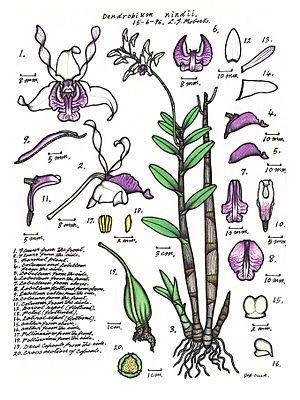Blue antler orchid facts for kids
Quick facts for kids Blue antler orchid |
|
|---|---|
 |
|
| Illustration by Lewis Roberts | |
| Conservation status | |
| Scientific classification | |
| Genus: |
Dendrobium
|
| Species: |
nindii
|
| Synonyms | |
|
|
The Dendrobium nindii, also known as the blue antler orchid, is a special kind of orchid. It is an epiphytic or lithophytic plant. This means it can grow on other plants or on rocks. It has tall, round, leafy stems called pseudobulbs. Its leaves are tough and dark green. The orchid produces up to twenty beautiful flowers. These flowers are usually mauve or violet. They have darker lines on their special lip-like part, called the labellum. You can find this antler orchid in tropical North Queensland, Australia, and in New Guinea.
Contents
What Does It Look Like?
The blue antler orchid is a herb that grows on trees or rocks. Its stems, called pseudobulbs, are dark brownish-black and shaped like cylinders. They can be from 0.5 to 2.5 meters (about 1.6 to 8.2 feet) long. These stems are also 30 to 40 millimeters (about 1.2 to 1.6 inches) wide. The upper part of the stem has many leaves.
Leaves and Flowers
This orchid has between six and twenty-two leaves. They are dark green and feel like leather. Each leaf is about 80 to 150 millimeters (3.1 to 5.9 inches) long. They are also 60 to 80 millimeters (2.4 to 3.1 inches) wide. The leaves grow in two rows along the pseudobulbs.
The flowers grow on a stem that comes from the tip of the pseudobulb. This flowering stem is 200 to 500 millimeters (7.9 to 19.7 inches) long. It holds about eight to twenty flowers. Each flower is 50 to 60 millimeters (2.0 to 2.4 inches) long and wide. Their colors are usually mauve or violet.
Flower Parts
The sepals and petals of the flower are a bit twisted. They spread out widely from each other. The side sepals are 30 to 40 millimeters (1.2 to 1.6 inches) long. They are also 14 to 18 millimeters (0.55 to 0.71 inches) wide. The top sepal is a little shorter. The petals are 35 to 50 millimeters (1.4 to 2.0 inches) long. They are thin, only 4 to 5 millimeters (0.16 to 0.20 inches) wide.
The labellum is the special lip-like part of the flower. It is mauve or violet with darker lines. It is about 40 millimeters (1.6 inches) long and wide. The labellum has three parts, called lobes. The two side lobes are quite big and curve upwards. They often have wavy edges. The middle lobe is shorter. It also has wavy edges and a flat, square-cut tip. This orchid usually blooms from July to September.
How It Got Its Name
The blue antler orchid was first officially described in 1874. This was done by a person named Walter Hill. He wrote about it in his Report on the Brisbane Botanic Garden. The plant he studied was found by Philip Henry Nind. It was growing on trees near rivers in Moresby and Johnstone River.
The special part of its scientific name, nindii, honors Philip Henry Nind. He was the one who collected the first plant specimen used to describe the species. This first plant is called the type specimen.
Where It Lives
The blue antler orchid grows in different places. It likes to live on trees, including mangroves and palms. You can find it in coastal swamps and rainforests near the coast. In Australia, it grows between the McIlwraith Range and Innisfail. This area is on the Cape York Peninsula. The orchid also lives in similar places in New Guinea. This includes the Vogelkop Peninsula and near the Eilanden River.
Why It Needs Our Help
This beautiful orchid is in danger. It is listed as "endangered" by the Australian Government. This means there are not many of these orchids left. It is also listed as endangered by the Queensland Government.
The main reasons this orchid is in trouble are:
- Land clearing: People are removing the places where it lives. This includes cutting down forests and clearing swamps.
- Illegal collection: Some people illegally take these orchids from the wild. This makes it even harder for them to survive.
Protecting these special plants helps keep our natural world healthy.


